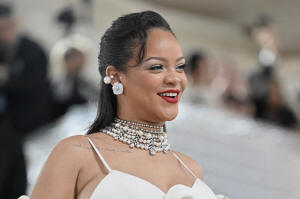Why Rihanna's expanding Clara Lionel Foundation is seen as a model for
celebrity philanthropy
[April 04, 2025]
By JAMES POLLARD
NEW YORK (AP) — Rihanna is accustomed to defying convention.
The nine-time Grammy winner has turned her wide-ranging string of hits,
including “Umbrella” and “Work,” into a business empire worth an
estimated $1.4 billion, placing her high on last year's Forbes list of
the richest “self-made” American women. The Barbados native stunned
entertainment’s biggest stage with a pregnancy reveal during her solo
2023 Super Bowl halftime show. And her successful Fenty Beauty cosmetics
brand revolutionized the makeup industry with its inclusive shades.
But it is not the megastar-turned-mogul's long-awaited follow-up to
2016's “Anti” album set to make waves this year. It's her philanthropy.
Named after Rihanna's grandparents and funded partially through her
brands, the Clara Lionel Foundation is coming off a “refresh” that is
poised to direct more funds toward climate solutions and women's
entrepreneurship in the under-invested regions of East Africa, the
Caribbean and the U.S. South. After 13 years of relative anonymity, the
nonprofit is ready for more visibility.
“Our founder is a woman from a small island nation who’s got global
reach. She’s an entrepreneur. She’s a mom. She’s a creative,” said
Executive Director Jessie Schutt-Aine. “So, we want an organization that
reflects that spirit and that energy. She’s bold and she’s ambitious.
She’s innovative. She always does things different. She’s a game
changer.”
Experts say it's rare to see such intentionality among famous
philanthropists. Clara Lionel Foundation has also garnered praise for
its embrace of “trust-based” giving, which empowers recipients with
unrestricted funding.

NDN Collective founder Nick Tilsen said CLF lets his Indigenous
power-building nonprofit “do the work on our terms” — and that other
funders should take notes.
“They’re not a foundation that’s all up in your business, either,”
Tilsen said. “They support. They see the work. They allow us to do what
we need to do.”
Clara Lionel Foundation's personal roots
Rihanna started the foundation with a $516,000 contribution after her
grandmother died of cancer complications in 2012. That year, the
musician established an oncology center at Barbados’ main hospital to
expand cancer screening and treatment. And the young foundation focused
on healthcare and Barbados for much of last decade.
By 2019, though, CLF had begun prioritizing emergency preparedness.
Grantmaking jumped to more than $33 million in 2020 as the nonprofit
provided much-needed pandemic relief and backed racial justice efforts.
Post-pandemic spending slowdowns coincided with its internal transition,
according to tax filings.
A revamped team and refined priorities now match its broader ambitions.
A new director for women's entrepreneurship, based in South Carolina,
will build out that pillar's programs. Black Feminist Fund co-founder
Amina Doherty now oversees programs and impact. Rounding out its five
new pillars are climate solutions, arts and culture, health access and
equity, and future generations.
The youth focus was commended by Ashley Lashley, a 25-year-old whose
foundation has worked with CLF to address environmental challenges in
her native Barbados. She often hears leaders say that ‘youth are the
future,' she said, but those statements rarely translate into actual
support.
“Rihanna’s foundation is a prime example of how women in power can help
contribute to work that is being done at the community level,” Lashley
said.
Rihanna told The Associated Press she hopes CLF will continue to be a
force for “global inclusion in philanthropy.”
She reflected on the foundation's 13-year transformation in a statement:
“Today we have global reach, but that notion of love for community and
for our roots runs deep in the DNA of the foundation."

Finding partners — big and small
The latest example of that evolution is a partnership with The Andrew W.
Mellon Foundation. Barbados' “invaluable history” as “an essential
chapter in the broader story of the African diaspora" is threatened by
climate change, according to a Mellon press release.
Together, the two foundations announced, they will fund “artist-led
initiatives” to protect that culture “while inspiring new narratives and
opportunities internationally.”
[to top of second column]
|

Rihanna shows off her baby bump at The Metropolitan Museum of Art's
Costume Institute benefit gala celebrating the opening of the "Karl
Lagerfeld: A Line of Beauty" exhibition on Monday, May 1, 2023, in
New York. (Photo by Evan Agostini/Invision/AP, File)
 Schutt-Aine views the partnership
with Mellon — the largest philanthropic supporter of the arts in the
U.S. — as a milestone for CLF. Justin Garrett Moore, the director of
the Mellon's Humanities in Place program, said the nonprofit's name
arose when his team asked contacts to recommend partners.
“We think there is an incredible platform that
Clara Lionel Foundation has, with their founder, to bring this type
of work into a legibility and visibility for the organizations that
will be supported,” Moore said. “Also, just generally in the
society, to help amplify the power of the arts.”
Among those grantees is a developmental performance arts program
that also provides free social services to students in the nation's
capital of Bridgetown. Operation Triple Threat founder Janelle
Headley said Clara Lionel Foundation helped the nonprofit afford a
warehouse outfitted with acoustics panels, sound equipment and a
dance floor.
The relationship began with a microgrant for scholarships. Operation
Triple Threat now receives general operating support — a
“revolutionary” investment, Headley said, because charitable
donations are usually earmarked for specific causes. That
flexibility proved especially helpful during the pandemic when
rapidly changing circumstances created new needs like iPads for
remote learning.
“It's uncommon, to be honest, to have someone give a sizable
donation unrestricted and say, ‘We trust you, your vision,’” Headley
said. “That is very forward-thinking of them.”
A unique model for celebrity philanthropy
The approach is unique, according to Mary Beth Collins, the
executive director of the Center for Community and Nonprofit Studies
at the University of Wisconsin-Madison. She finds that celebrities
typically engage in philanthropy only when necessary.
But Collins said CLF appears to think long-term about its partners
and deliberately in its bottom-up funding. The strategies align with
her own recommendations to engage expert professionals, address root
causes, select focus areas important to founders and lift up leaders
living those issues.

“We want to see funds and resources from the more endowed people in
the world going to those leaders on the ground that really know the
place and the experience and the issues best,” Collins said.
CLF used that model late last year when it provided additional
funding to a clean energy nonprofit partner impacted by Hurricane
Helene. Melanie Allen, co-director of The Hive Fund for Climate and
Gender Justice, said they suddenly received around $60,000 to
quickly distribute among vetted partners in devastated communities.
The contribution came amid an increasingly hostile environment for
nonprofits like hers supporting women of color, which has prompted
some philanthropists to reduce giving. Allen said she is excited
about CLF’s “deep commitment to the South going forward.”
As others reduce resources, CLF wants to bring more philanthropic
partners to the table. They're planning a summer convening for
grantees to expand networks. The message, CLF's Doherty said, is “We
will stick with you.”
“Some people might say times look bleak," Doherty said. "But this is
a moment of possibility.”
The importance of remaining grounded in communities you serve is a
lesson Schutt-Aine learned throughout a 25-year global health
career.
Most recently the Chief of Equity, Gender and Cultural Diversity at
the Pan American Health Organization, Schutt-Aine has treated the
world’s deadliest infections of tuberculosis, malaria and HIV/AIDS.
“If you’re going to work on malaria," she said, “you need to have
lived with the mosquito.”
All contents © copyright 2025 Associated Press. All rights reserved |